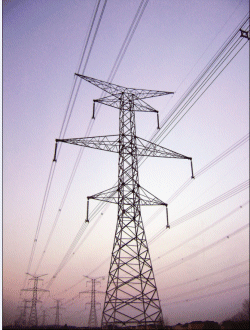In a recent address to Congress, President Obama said, “The nation that leads in the creation of a clean energy economy will be the nation that leads the 21st century’s global economy.” The smart electric grid and other grid ideas might play a role in this endeavor. According to the U.S. Department of Energy, implementing the “smart grid” is expected to cost $165 billion over 20 years. Sensors and communications on the grid are the focus for this but there may be other areas than can help even more.
It is hard for this writer to see where spending $165 billion on smarts for the wires is going to help all that much. However, the utilities do like the ability the smarts will give to monitor each line. Load distribution is an important factor because covering peak loads means using more-expensive and less-efficient generation, and understanding load conditions via sensors on the grid can be a big help.
The New Jersey Institute of Technology is designing an MEMS acoustic sensor that will eavesdrop on transformers, reporting signs of deterioration. Intermittent arcing in transformers can go on for years, sapping system efficiency and cutting reliability.
Sandia National Laboratory in Albuquerque, NM, is applying microsensors to transmission lines to measure strain in the grid and identify stressed points, allowing adjustments to avert power dips or outages. This is important for reliability, but does not help much with energy.
What can be done about the grid energy losses? According to Ben McConnell at Oak Ridge National Laboratory, losses from the generator to end-user are around 7% to 8%. “This includes a nominal three to four stages of transformation (generator step-up, transmission, sub-transmission or distribution substation, and distribution) plus the line losses in transmission/distribution. Total transformation losses are 3% to 4% and line losses are 3% to 4%. The main reason these losses are low is the high transmission and distribution voltages, plus excellent transformer design.” Typical long-distance ac transmission lines run at 155,000 to 765,000 V.

McConnell also noted that “the solid state transformer (SST) has been proposed as an alternative to conventional designs, but the higher cost, higher voltage levels, switching losses, and possible filter losses in the designs have made the concept non-competitive in most applications. One benefit for the SST may be weight and perhaps volume, which makes the SST a good candidate for emergency power applications. ORNL has looked at the SST in the past and continues to do so.”
Dc transmission is used world wide for long-distance HV transmission (>300 miles) and interconnections between systems of different frequency (50 vs. 60 Hz) or for flow and stability control in synchronous interconnections. Losses in ac-dc-ac conversion are made up for by higher voltage levels, plus lower footprint (right-of-way) required by the HVDC lines.
There has also been lots of talk about superconducting cables for the grid. High-temperature superconductor (HTS) cables are now offered by a couple of companies, including American Superconductor (www.amsc.com). But it is a bit hard for me to see how expensive wires that have to be cooled to 150C are going to help us much, even with zero resistance.
Where engineering might help the most is not really in the grid, but in solar power conversion. It seems to me that solar can do a lot to ease the peak loads on the grid. Solar installations are growing. As of earlier this year, San Diego had 2,267 solar roofs totaling 19,452 kW, San Francisco 1,493 totaling 12,763 kW. These can make a big dent in the peak power on high air conditioning load days and for daytime office lighting. Of course, you can’t rely on solar at night or with a very cloudy sky. Somebody needs to come up with a really good short-term energy storage method.
Companies like Enphase Energy (Petaluma, CA) are making micro-inverters that fit on each of the solar panels in a solar array. These 95%-efficient inverters greatly improve the system output because if one panel is shaded in a standard system the whole array output drops, but with an inverter on each array, only the affected panel(s) lose some output. Overall panel output can go up 15% to 25%. National Semiconductor makes a unit they call SolarMagic Power Optimizers that does something similar.
So, here is an area where good engineering is making a difference. Let’s find some more. If you have any viewpoints on this topic, please send them to me.
Jim Harrison
Where can electronic engineers contribute to grid efficiency?
Advertisement
Learn more about Electronic Products Magazine





